NEON BILLBOARDS OF FORGOTTEN BUSINESSES
So there’s this building in Red Hook with a gigantic neon billboard framework on it, and the other letters of the ad are long gone except for one gigantic “R” with a period next to it. What did the R stand for? What did it help to advertise? Why are the other letters missing? Your webmaster just found out.
The Gowanus Canal section of Brooklyn has long been a fascinating neighborhood, caught as it is between affluent Park Slope and Cobble Hill on one side, and tough-as-nails Red Hook on the other. For decades, the Gowanus Canal itself was a fetid waterway populated by four-eyed fish and other biological unspeakables. These days, the canal itself is being pumped clean, and the immediate neighborhood is making a comeback.
Take a ride on the F or G train as it makes the giant curve and climbs over 80 feet above the canal, and take a look out the window on either side. You’ll see giant metal frameworks with immense neon ads hung high over the neighborhood. Advertisers considered both the IND subway and the Gowanus Expressway as prime territory to imprint their wares on the engrams of commuters making their way into Manhattan from Bay Ridge, Flatbush, Gravesend and all points of Kings County.
Now, though, most of the businesses these neon giants beamed forth for miles around are gone. Like dinosaur bones, these signs are the only tangible reminder that they once existed. Though the businesses are gone, these signs are as indelibly Brooklyn as the Hollywood sign is Los Angeles. (Though admittedly, the giant signs are still there because it would be a pain in the neck to remove the giant superstructures.)
Smith-9th Street IND platform
KENTILE FLOORS 2nd Avenue and 9th Street
Kentile was founded by Arthur Kennedy in 1898 and once billed itself as “America’s largest manufacturers of super-resilient floor tile.” Kentile hung in there till just a couple of years ago following a series of strikes and costly asbestos lawsuits. It’s purple neon sign no longer burns brightly but it reminds folks for miles around that there was once a Kentile.
EAGLE CLOTHES 3rd Avenue and 6th Street
Eagle is one of the many haberdasheries that succumbed to more casual living during the Swingin’ Sixties. As more men began to eschew suits, jackets and ties during all but strict business hours, clothing manufacturers had to adapt or die.
One by one, Weber & Heilbroner, Rogers Peet, Robert Hall all succumbed. Many of their ads can still be found too, in faded ads on buildings in and surrounding Manhattan’s Garment District. The biggest remnant of the era when all guys wore hats is right here by the Gowanus Canal, with his neon sign for the manufacturer’s local factory that went up in 1951.
Casual dress for work reached its apogee in the late 1990s with the rise of tech dot.com companies, but since those have collapsed and there’s more of an emphasis on traditional business, maybe there will again be a need for companies like Eagle Clothes as people wear suits to work again. Then again, maybe not. (2020: the Covid Pandemic has forced many to work at home, where many people do so in their pajamas.)
BRUNO TRUCK SALES, Hamilton Avenue and 14th Street
Bruno Truck Sales has also joined its compatriots in the dust bin, but it’s the only concern along the Gowanus that maintains a current, old fashioned neon sign that attempts to attract motorists stuck in traffic along the increasingly decrepit Gowanus Expressway. It rests atop a NYC Sanitation building. This is the only sign on this page that remains standing in 2021.
JOHN TURANO & SONS FURNITURE, Richards & Verona Streets
You might be saying, if this was a sign for Turano & Sons, what’s that period doing to the left of the “R”? And you’d have a point. J. Turano perhaps? That’s not it at all.
When John Turano bought the building in 1978, the previous business to occupy the site was paper-goods manufacturer E.J. Trum, and Trum’s gigantic sign occupied the frame. When Turano attempted to pull down the letters to install his own sign, the “R” wouldn’t budge, and the lone “R” has been a part of Red Hook’s landscape for 22 years.
Past the barbed wire and guard dogs, ladies & gentlemen, E.J. Trum.
Sources:
Mark Jacobson, “Signs of the Times,” New York Magazine, February 19, 2001.
Thanks to Forgotten Fan Mary Ondrejka for her help with this page.

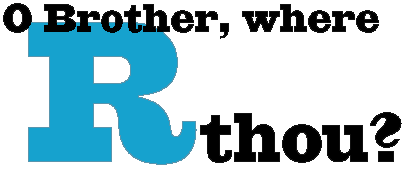
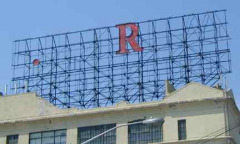
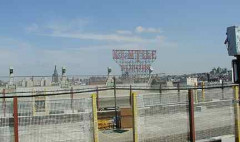
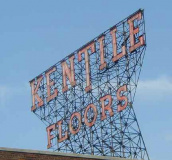
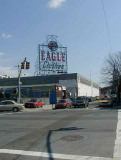
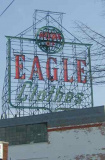
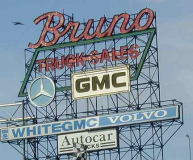
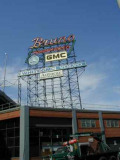


1 comment
[…] business from the passing IND trains on the viaduct, looms over 9th Street near the Gowanus Canal. It is one of a number of now-defunct large neon signs that can be found in the Gowanus and Red Hook areas, springing up from the 30s through the 50s to […]
Comments are closed.